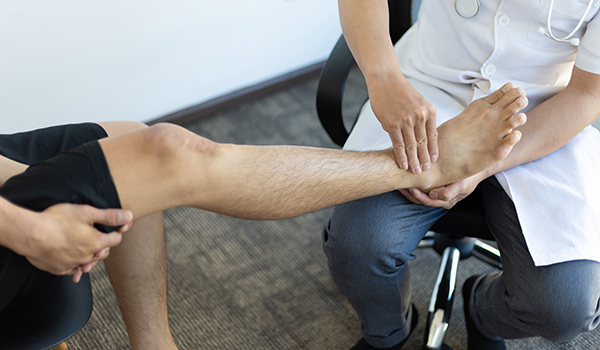Fractures
Fractures are not just complete breaks in the bone. They can also be cracks, and can occur in any bone in the body. This means that even severe fractures can sometimes go unnoticed for months without proper care.
UNDERSTANDING FRACTURES
Overview
Our lower limbs and feet are specifically vulnerable to stress fractures because of the repetitive forces inflicted on them during walking, activities and daily life. Depending on the nature of the activity, the foot and ankle may experience a load of up to 300% your body weight. Contrary to popular understanding, those with low levels of activity can also sustain foot fractures.
Fractures can occur in the calcaneus, cuboid, navicular or any other part of the ankle and foot.

What are the symptoms and causes of fractures?
Symptoms
Sharp pain or soreness on the outside of the foot which may spread to the outside of the ankle
Stiffness and soreness while doing ankle circles
Pain during weight-bearing activities or after activities
Ankle instability
Causes
Sudden acute injury to the tendons
Increased load such as running
Improper footwear
Biomechanical issues such as high arch or flat feet
Previous ankle injury/ sprain
What are the symptoms of fractures?
Lifestyle changes in recent years have also increased the risk factors for many. These can include:
Increased osteoporosis rates due to nutrient poor diets and a rise in eating disorders such as vitamin D, vitamin B12 deficiency or anorexia
Hard and flat walking surfaces such as marble, cement, or asphalt
Hot and humid weather encourages patients to wear open toe, slip-on and soft footwear such as flip flops which offer no support, leading to injuries and foot deformities
Increased participation in high intensity interval training such as Zumba, Circuit Training, Boxing and other high intensity sports
Technological advances have created a more sedentary lifestyle, causing to a deterioration in both bone and muscle strength
Increased use of high heels, causing a change in the biomechanical forces applied to the feet
Our lower limbs and feet are specifically vulnerable to stress fractures because of the repetitive forces inflicted on them during walking, activities and daily life. Depending on the nature of the activity, the foot and ankle may experience a load of up to 300% your body weight. Contrary to popular understanding, those with low levels of activity can also sustain foot fractures.
Fractures can occur in the calcaneus, cuboid, navicular or any other part of the ankle and foot.
Some patients may be convinced that have the mindset that since they have been doing these activities for so many years yet never experienced any pain, then there is no problem. However, just a subtle change to your routine may result in the onset of a fracture. For example:
Changing to a new exercise routine involving different forces or directional changes.
Increasing intensity of workouts.
Osteoporosis weakened the bones over time.
Changing environment surfaces such as treadmill to outdoors.
How do fractures typically present?
Sharp, sudden pain at the site of the fracture
Pain that might spread to other areas
Tenderness, swelling, or bruising where the injury is
Pain that eases with rest but comes back with activity
Throbbing pain that might worsen at night
A dull, aching feeling
Most fractures can be treated without surgery, but you’ll need to rest and keep the injured area still for 4 to 8 weeks. Tests like ultrasounds or X-rays help show the details of the injury and guide treatment. Severe fractures might need surgery. It’s important to see a podiatrist to avoid a longer recovery time and possible complications.
How can a podiatrist help with my fracture?
At NoFrills Podiatry, our podiatrists use advanced techniques to help you recover quickly from a fracture. The exact treatment depends on the type of fracture and your diagnosis. Some of the methods we might use include:

Casting or splinting:
Using soft, hard, fixed, or removable casts or splints to support the injured area.
Regular check-ups:
Weekly reviews to monitor progress.
Bone healing treatments:
Techniques like Super-Inductive Therapy (SIS) or Focal Extracorporeal Shockwave Therapy (ESWT) to speed up healing.
Rehabilitation:
Exercises and gait training to help restore muscle strength and movement.
Most fractures can be treated without surgery, but you’ll need to rest and keep the injured area still for 4 to 8 weeks. Tests like ultrasounds or X-rays help show the details of the injury and guide treatment. Severe fractures might need surgery. It’s important to see a podiatrist to avoid a longer recovery time and possible complications.
Book your initial podiatry visit
hello@nofrillspodiatry.com
Phone
9007 1085
Open Hours
Mondays - Sundays: 9am-6pm
We're Here Whenever You Need Us
hello@nofrillspodiatry.com
Contact Us
9007 1085
Open Hours
Monday-Sundays: 10am to 7pm
Address
About
About Us
Symptoms We Help With
FAQs
Careers
Contact Us